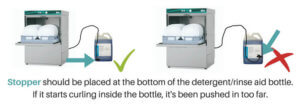Resources & helpful hints
FAQs
Q: Why can’t I use a regular dishwashing detergent in my commercial dishwasher?
A: Detergents for commercial use are specially formulated to be low sudsing whereas regular domestic dish washer detergents are higher sudsing and do not break down quickly enough to use during the fast cycles of a commercial machine (cycle times normally between 1 & 3 minutes) therefore your dish washer ends up retaining lots of suds, causing flooding through the door and a soap build up on the wash chamber walls and roof leading to spotting on your plates and glassware.
Q: Dishwasher Chemicals not feeding right? – Check if the stopper is in the right place.

A: Correct placement for detergent / rinse aid doser valve (stopper)
Q: Why is my dishwasher overflowing with suds?
Is your commercial dishwasher is doing this!

90% of the time this happens is because some domestic detergent has found its way into the dishwasher, either through pre-washing with a domestic detergent or using the incorrect detergent into the dishwasher.
• First thing to do is to remove the detergent & rinse aid hoses from the chemicals – lift it up to the top of the bottle so that no more solution can flow through the tubes,
• Next: turn on the cycle and let the machine fill, then drain it.
• After m/c is drained, open it up and wipe out the entire
inside with a damp cloth
• Do the above 2 steps again – you may need to do this, 2 to 4 times to remove ALL of the built-up detergent.
• Once the inside looks clean & suds free, then you can move the detergent tubes back into the detergent & rinse aid solutions.
• Please always ensure that no-one rinses any items with a domestic sink detergent before loading items into the dishwasher as this will build up the suds again.
The other 10% of the time is if there is
1) an issue with the detergent hoses or detergent doser causing too much detergent per wash.
2) slow filling of the dishwasher – this could be caused by low water pressure.
3) machine not draining or draining too slow, - blocked drain.
Q: What should I do if there is a white scale build up on the inside of the machine?
A: You will need to do a descale using our K23 Descale liquid and follow the instructions here. We recommend a descale every month to keep your glass / dishwasher in tip top condition.
Q: What do I need to do if I will not be using the machine for more than a week?
A: Follow our shut down procedures, and start up procedures.
How do I know the difference between a 10 amp & a 15 amp power point?
The image below shows that the 15 amp has a larger earth pin than the 10 amp
Q: What should I do if there is a white scale build up on the inside of the machine?
A: You will need to do a descale using our K23 Descale liquid and follow the instructions here.
Q: What do I need to do if I will not be using the machine for more than a week?
A: Follow our shut down procedures, and start up procedures.
Q: How do I know the difference between a 10 amp & a 15 amp power point?
A: The image below shows that the 15 amp has a larger earth pin than the 10 amp.
15 amp or 3 Phase are required for most commercial glass and dishwashers - always check your power availability before purchasing your new commercial glass or dish washer.

Q: Does my commercial glass or dishwasher require connection to HOT or COLD water?
A: Most models do require connection direct to hot water.
Hot water connection ensures fastest wash times.
There are a few models that can be set up direct to cold water - please contact us if you need to go this route.
